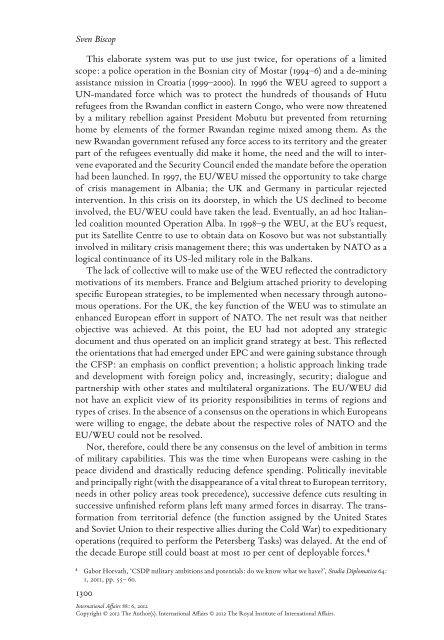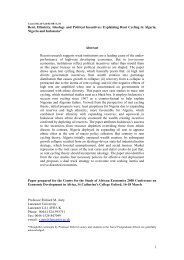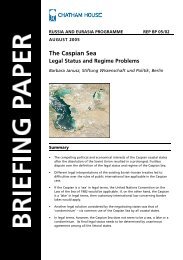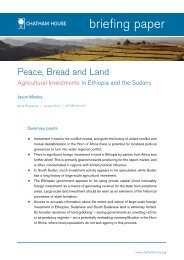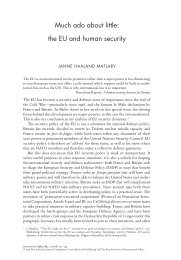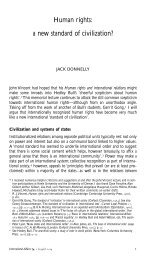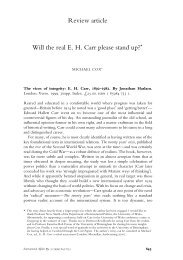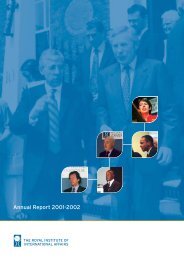The UK and European defence: leading or leaving? - Chatham House
The UK and European defence: leading or leaving? - Chatham House
The UK and European defence: leading or leaving? - Chatham House
You also want an ePaper? Increase the reach of your titles
YUMPU automatically turns print PDFs into web optimized ePapers that Google loves.
Sven Biscop<br />
This elab<strong>or</strong>ate system was put to use just twice, f<strong>or</strong> operations of a limited<br />
scope: a police operation in the Bosnian city of Mostar (1994–6) <strong>and</strong> a de-mining<br />
assistance mission in Croatia (1999–2000). In 1996 the WEU agreed to supp<strong>or</strong>t a<br />
UN-m<strong>and</strong>ated f<strong>or</strong>ce which was to protect the hundreds of thous<strong>and</strong>s of Hutu<br />
refugees from the Rw<strong>and</strong>an conflict in eastern Congo, who were now threatened<br />
by a military rebellion against President Mobutu but prevented from returning<br />
home by elements of the f<strong>or</strong>mer Rw<strong>and</strong>an regime mixed among them. As the<br />
new Rw<strong>and</strong>an government refused any f<strong>or</strong>ce access to its territ<strong>or</strong>y <strong>and</strong> the greater<br />
part of the refugees eventually did make it home, the need <strong>and</strong> the will to intervene<br />
evap<strong>or</strong>ated <strong>and</strong> the Security Council ended the m<strong>and</strong>ate bef<strong>or</strong>e the operation<br />
had been launched. In 1997, the EU/WEU missed the opp<strong>or</strong>tunity to take charge<br />
of crisis management in Albania; the <strong>UK</strong> <strong>and</strong> Germany in particular rejected<br />
intervention. In this crisis on its do<strong>or</strong>step, in which the US declined to become<br />
involved, the EU/WEU could have taken the lead. Eventually, an ad hoc Italianled<br />
coalition mounted Operation Alba. In 1998–9 the WEU, at the EU’s request,<br />
put its Satellite Centre to use to obtain data on Kosovo but was not substantially<br />
involved in military crisis management there; this was undertaken by NATO as a<br />
logical continuance of its US-led military role in the Balkans.<br />
<strong>The</strong> lack of collective will to make use of the WEU reflected the contra dict<strong>or</strong>y<br />
motivations of its members. France <strong>and</strong> Belgium attached pri<strong>or</strong>ity to developing<br />
specific <strong>European</strong> strategies, to be implemented when necessary through autonomous<br />
operations. F<strong>or</strong> the <strong>UK</strong>, the key function of the WEU was to stimulate an<br />
enhanced <strong>European</strong> eff<strong>or</strong>t in supp<strong>or</strong>t of NATO. <strong>The</strong> net result was that neither<br />
objective was achieved. At this point, the EU had not adopted any strategic<br />
document <strong>and</strong> thus operated on an implicit gr<strong>and</strong> strategy at best. This reflected<br />
the <strong>or</strong>ientations that had emerged under EPC <strong>and</strong> were gaining substance through<br />
the CFSP: an emphasis on conflict prevention; a holistic approach linking trade<br />
<strong>and</strong> development with f<strong>or</strong>eign policy <strong>and</strong>, increasingly, security; dialogue <strong>and</strong><br />
partnership with other states <strong>and</strong> multilateral <strong>or</strong>ganizations. <strong>The</strong> EU/WEU did<br />
not have an explicit view of its pri<strong>or</strong>ity responsibilities in terms of regions <strong>and</strong><br />
types of crises. In the absence of a consensus on the operations in which <strong>European</strong>s<br />
were willing to engage, the debate about the respective roles of NATO <strong>and</strong> the<br />
EU/WEU could not be resolved.<br />
N<strong>or</strong>, theref<strong>or</strong>e, could there be any consensus on the level of ambition in terms<br />
of military capabilities. This was the time when <strong>European</strong>s were cashing in the<br />
peace dividend <strong>and</strong> drastically reducing <strong>defence</strong> spending. Politically inevitable<br />
<strong>and</strong> principally right (with the disappearance of a vital threat to <strong>European</strong> territ<strong>or</strong>y,<br />
needs in other policy areas took precedence), successive <strong>defence</strong> cuts resulting in<br />
successive unfinished ref<strong>or</strong>m plans left many armed f<strong>or</strong>ces in disarray. <strong>The</strong> transf<strong>or</strong>mation<br />
from territ<strong>or</strong>ial <strong>defence</strong> (the function assigned by the United States<br />
<strong>and</strong> Soviet Union to their respective allies during the Cold War) to expeditionary<br />
operations (required to perf<strong>or</strong>m the Petersberg Tasks) was delayed. At the end of<br />
the decade Europe still could boast at most 10 per cent of deployable f<strong>or</strong>ces. 4<br />
4<br />
Gab<strong>or</strong> H<strong>or</strong>vath, ‘CSDP military ambitions <strong>and</strong> potentials: do we know what we have?’, Studia Diplomatica 64:<br />
1, 2011, pp. 55– 60.<br />
1300<br />
International Affairs 88: 6, 2012<br />
Copyright © 2012 <strong>The</strong> Auth<strong>or</strong>(s). International Affairs © 2012 <strong>The</strong> Royal Institute of International Affairs.


